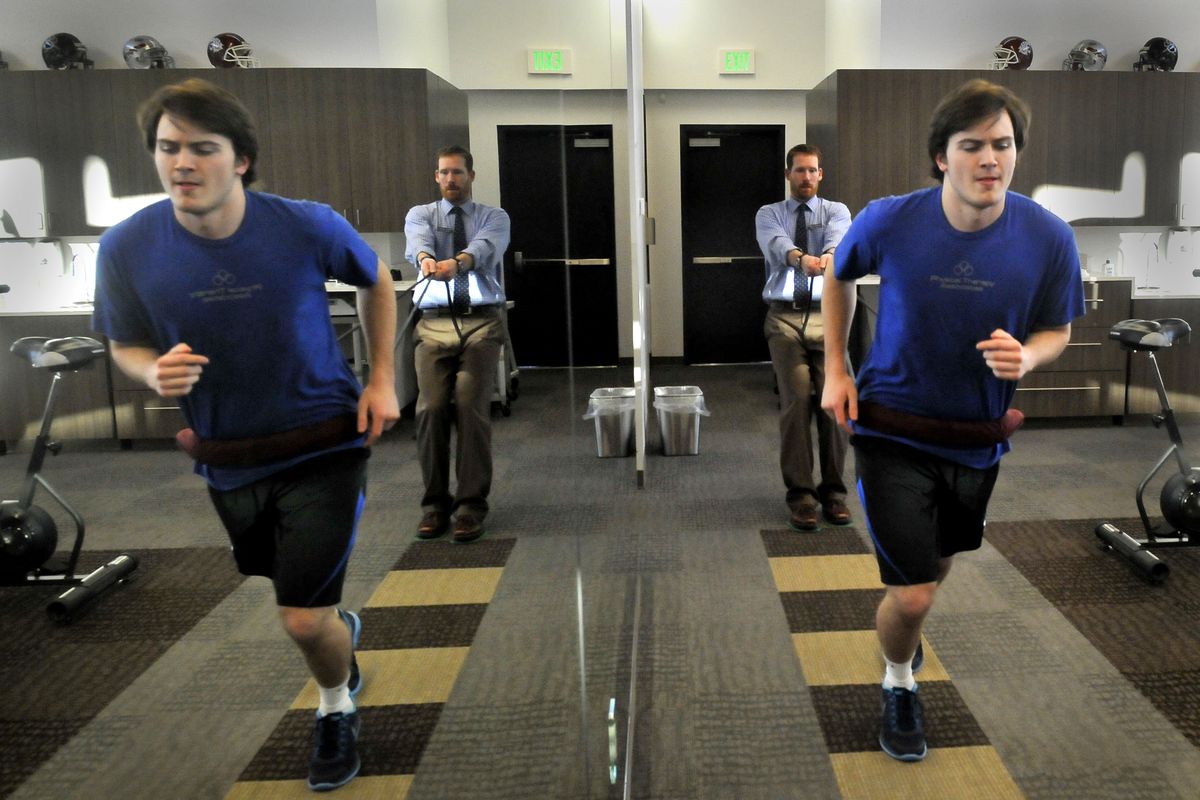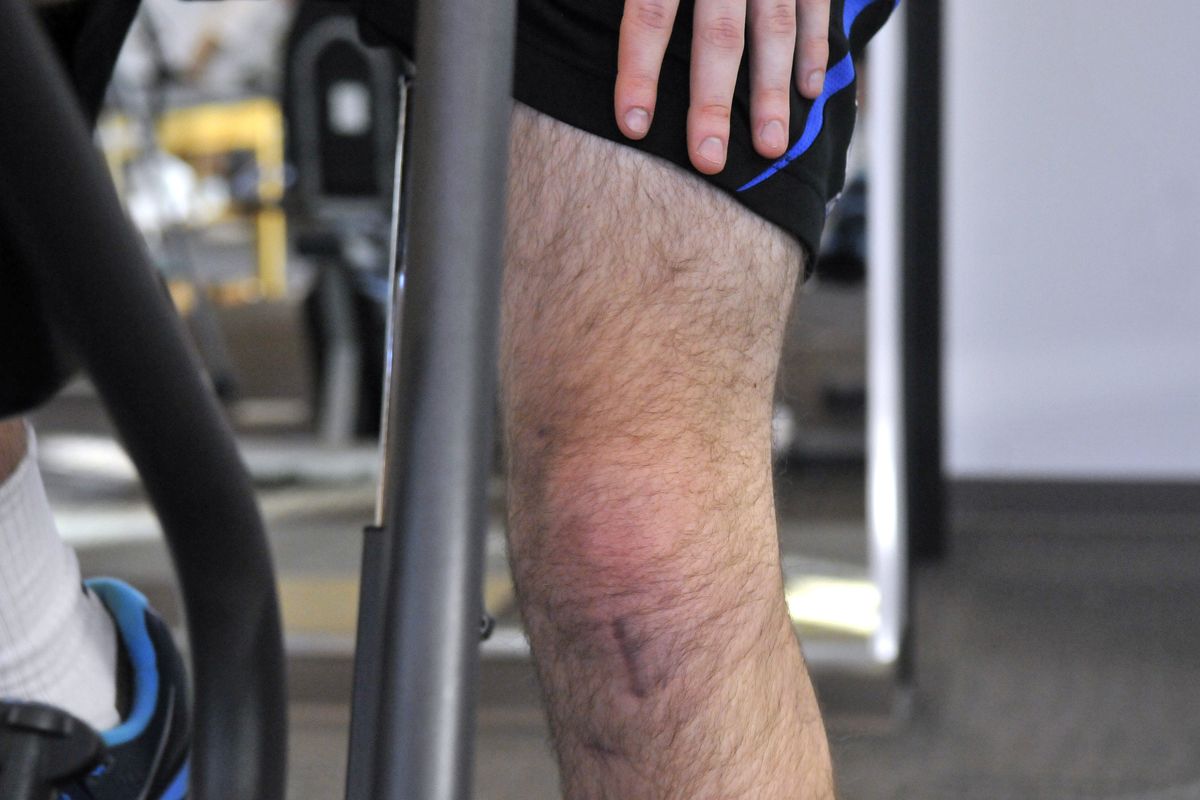Area athletes deal with devastation of ACL injuries
Three months after surgery to repair his ACL, G-Prep junior Reed Hopkins pulls against resistance of physical therapist Craig Henneberry. (JESSE TINSLEY PHOTOS)
All she was doing was dribbling up the floor. It prompted her mom, Robin, to start yelling at her. She abruptly stopped yelling, almost hoping she could take it back. She knew something was wrong with her daughter.
Molly Barnhart, a Central Valley junior, had just navigated herself through full-court pressure when she planted her left foot.
“My left knee felt like it went left and then right – just like RGIII did in the playoff game against Seattle,” Barnhart said. “I just remember I came out of the game and looked up at the scoreboard and thought, ‘really?’ ”
Barnhart had suffered an all-too-common injury – a torn anterior cruciate ligament (ACL).
“It was just a freaky thing,” she said. “It was just the way I landed. I hadn’t had any previous problems with my knees.”
Seven area basketball players, including Barnhart, have suffered season-ending knee injuries that required reconstructive surgery. Each player plans on playing next year and beyond.
Gonzaga Prep senior Madison Wright hopes to recover in time to play at Southern Utah University her freshman year. She signed a letter of intent in November and tore her ACL in late December.
Wright had surgery last week. She was in a wheelchair Tuesday for pregame festivities honoring the seniors.
Wright said she noticed some instability in her knees two weeks prior to her injury. She never thought she might be on the verge of tearing her ACL.
“It wasn’t on my mind at all,” Wright said. “It had been a little sore or bruised.”
It was a nonleague game against Bellarmine Prep during the holidays when Wright injured her knee. She was dribbling during a fast break when she planted her left foot.
“My momentum was going pretty fast that I might have stepped funny,” Wright said. “When I planted with my right foot my (right) knee buckled. After I felt the pop I knew it was gone.”
Wright waited for about a month before having surgery. That’s about the average lag time from injury to reconstruction. The surgeon wants to allow for any collateral injuries to heal and wants to see the athlete do some pre-surgery rehab to gain back range of motion with the knee.
“It turned out there was more damage than what showed on the MRI (magnetic resonance imaging),” a groggy Wright said the day after the surgery.
The average length of recovery is about six to eight months. If she’s able to start playing by next October, she’d like to play immediately at Southern Utah.
“It’s not the end,” Wright said. “I’ll still be able to play. And I’ll be stronger than I was before.”
University junior Cassie Shillam has torn her ACL twice. She blew out her right knee her freshman year and hurt the left knee in late December.
“I was doing a jump stop to do a layup,” Shillam said of the recent injury. “Last time, I had pain all the way up until surgery. This time I had virtually no pain.”
Shillam was back playing in eight months after the first injury, returning in time for her sophomore season.
“It was a struggle for a while,” Shillam recalls. “Trying to get your mojo back and convincing your brain that you’re ready to go is tough. It probably took me until midway in the season until I felt like my old self.”
Since she’s been through the rehabilitation routine already, Shillam hopes to push the recovery to six months so she’ll have some time to get back to her normal routine before her senior season.
Shillam believes her injuries could be genetic. Her father, Terry Shillam, an East Valley graduate, suffered ACL injuries in both of his knees in high school. An all-state running back, he went on to play at the University of Montana.
Shadle Park’s Kionte Brown and Gonzaga Prep’s Reed Hopkins suffered their injuries during a first-year fall league at Spokane Community College.
Hopkins, a starter last year, tore his ACL in late September; Brown, a three-year starter, tore his in late October. Both have had surgery and are well on their way to recovering.
For Hopkins, torn ACLs run in the family. He’s the youngest of three siblings, and all three have torn ACLs.
“I think I was bound to tear mine,” Reed said. “My doctor believes it was genetic. It was devastating to me. I’m just trying to move on from it.”
Brown said he was doing what he normally does when he ripped up his left knee.
“I went for a regular layup like I’ve done a thousand times,” Brown said. “I went off two feet and heard a pop.”
About two weeks after the injury, Brown was running lightly and shooting jump shots.
At that point, Brown’s doctor thought it was a partial tear. The doctor told Brown he could try to play on it this year and have surgery after the season or have surgery immediately and be recovered for his first year in college.
He decided to have surgery in mid December.
Initially, the doctor couldn’t find his ACL.
“It had curled up in a little ball behind (a bone),” Brown said. “Surgery went well. I’m healing faster than they’d hoped.”
Freeman’s Kellen Miller and Northwest Christian’s Dakota Winward were first-team all-league selections last year.
“I got a steal and we were on a fast break,” Miller said. “I jumped to the right for a layin off both feet and I heard it pop.”
He injured his left knee in the third game of the season.
“They said my knee will be stronger,” said Miller, a three-year starter. “You have to keep your head up and do your rehab.”
Winward, also a three-year starter, suffered his injury in the season opener. When he came down from a jump shot he collapsed.
“I was pretty devastated,” said Winward, who hoped to lead his team to the State 2B title game for a third straight year. “I heard a pop. It kind of felt like a twig snapping.”
Winward said it was probably inevitable he would injure his knee.
“I apparently had been playing on a partial ACL for three years,” Winward said. “It happened my freshman year. I went in for an MRI because my knee was giving me trouble, but they didn’t look at the ACL. They thought it was something else. It felt more like a sprain than anything else. I had a little therapy and it was fine until I tore it.”

